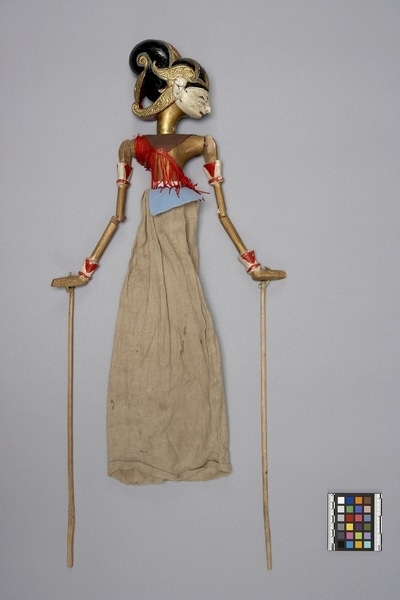Rod Puppet Item Number: Ib308 from the MOA: University of British Columbia


Description
Three-dimensional, wooden, male humanoid puppet. Figure has a wooden body (part a), with wooden, carved head (part b), and pointed rod (part c). White face with black facial details below eyes and near eyebrows. Red lips. Slit shaped eyes and forward bending face. Black, upswept hair with gold, white and red headdress and ear ornaments. Bronze coloured body; moveable jointed arms with sticks attached to hands. Brown cloth yoke with red satin (?) fringe. Red and white wrist and upper arm bracelets. White waistband with two blue circles. Rough unpainted wooden handle extending through body to head.
History Of Use
Javanese puppetry as an art form probably developed by the 11th century. The three-dimensional wooden wayang golek puppets of western Java, which are to be distinguished from the earlier and more sacred wayang kulit shadow plays puppets or other forms, appeared during the 16th century. Originally the plays depicted Javanese mythology, but after the Indian conquest of Java the Hindu epics, Ramayana and Mahabharata, were incorporated into the cycles, which comprise about 200 plays. An individual or group hires a dalang (puppet-master) to celebrate important occasions. The performances often last all night and are generally presented in three acts, with vocal and instrumental accompaniment. The individual plays vary widely in detail but usually involve conflict between good and evil. They serve a moral and religious purpose, and more recently, one of political commentary. Each puppet's character is represented by its appearance and placement onstage; protagonists with strong elements of good are placed to the right, antagonists of violent or evil nature to the left. In the Mahabharata, a conflict between the noble Pandawa brothers and the evil Kurawas constitutes the main plot, which allows an exploration of the good and evil characteristics of members of both sides and the inevitable triumph of good. Yudistra, eldest of the Pandawas, is considered a great hero and the most refined of the wayang figures.
Cultural Context
Theatrical performance.
Iconographic Meaning
Small nose, slit shaped eyes, ear ornaments, up-swinging coil of hair and forward canted white face are distinguishing characteristics of Yudistra, the eldest of the Pandawa brothers. Nobility and refined character are indicated by the white face and facial features while the posture of the head and position of the eyes (downcast) are symbolic of ideal inner peace and unity between the self and its surrounding. Richness of clothes, headdress and other decoration usually associated with characters of great nobility and wealth.
Item History
- Made in Java, Indonesia
- Owned by Tradewind Antiques before March 15, 1983
- Received from Museum of Anthropology Shop Volunteers (Funding source) and Tradewind Antiques (Seller) on March 15, 1983
What
- Name
- Rod Puppet
- Identification Number
- Ib308
- Type of Item
- puppet
- Material
- wood, cotton fibre, paint and synthetic fibre
- Manufacturing Technique
- carved, painted, machine woven, machine stitched and batiked
- Part A
- height 67.0 cm, width 18.0 cm, depth 6.0 cm
- Part B
- height 15.0 cm, width 6.3 cm, depth 13.0 cm
- Part C
- height 30.0 cm, width 3.0 cm, depth 2.0 cm
Who
- Culture
- Sundanese
- Previous Owner
- Tradewind Antiques
- Received from
- Museum of Anthropology Shop Volunteers (Funding source) and Tradewind Antiques (Seller)
Where
- Holding Institution
- MOA: University of British Columbia
- Made in
- Java, Indonesia
When
- Ownership Date
- before March 15, 1983
- Acquisition Date
- on March 15, 1983
Other
- Condition
- good
- Accession Number
- 0886/0042